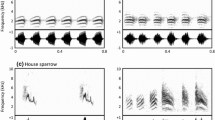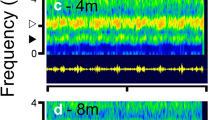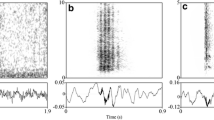Abstract
-
1.
The envelope periodicity of communication signals is an important feature distinguishing advertisement and aggressive calls for the green treefrog (Hyla cinerea). Envelope periodicity, a cue for periodicity pitch perception in humans, is affected by the fine-structure of the signal, a cue for timbre perception in humans. The present study examined perception of two acoustic features affecting waveform fine-structure — harmonic structure and phase structure — in male green treefrogs.
-
2.
We analyzed evoked vocal responses of male green treefrogs living in laboratory arenas to playbacks of digitally-generated signals resembling either conspecific advertisement or aggressive calls in their first harmonic periodicity. Systematic changes in the harmonic structure of these signals were achieved by varying the harmonic relations between frequency components in the signals, and changes in phase structure were achieved by varying the starting phases of harmonically-related components.
-
3.
Calling was significantly influenced by the first harmonic periodicity of the signals. Males vocalized more to signals with the periodicity of the advertisement than the aggressive call. There were no differences in response to harmonic and inharmonic signals with similar spectral content. Phase structure did not significantly influence vocal responses.
-
4.
These results suggest that the fine-structure (“timbre”) of complex acoustic signals is not a significant feature guiding behavior tested using a communication response in this species.
Similar content being viewed by others
References
Allan SE, Simmons AM (1993) Temporal features mediating call recognition in the green treefrog, Hyla cinerea: Amplitude modulation. Anim Behav (in press)
Batschelet E (1981) Circular statistics in biology. Academic Press, London
Bilsen FA (1973) On the influence of the number and phase of harmonics on the perceptibility of the pitch of complex signals. Acustica 28:60–65
Boer E de (1956) Pitch of inharmonic signals. Nature 178:535–536
Forester DM, Czarnowsky R (1985) Sexual selection in the spring peeper, Hyla crucifer (Amphibia, Anura): role of the advertisement call. Behaviour 92:112–128
Gerhardt HC (1978) Mating call recognition in the green treefrog (Hyla cinerea): The significance of some fine-temporal properties. J Exp Biol 74:59–73
Gerhardt HC (1981) Mating call recognition in the barking treefrog (Hyla gratiosa): responses to synthetic mating calls and comparisons with the green treefrog (Hyla cinerea). J Comp Physiol 144:17–25
Gerhardt HC (1987) Evolutionary and neurobiological implications of selective phono taxis in the green treefrog, Hyla cinerea. Anim Behav 35:1479–1489
Gerhardt HC (1988) Acoustic properties used in call recognition by frogs and toads. In: Fritzsch B, Ryan MJ, Wilczynski W, Hetherington TE, Walkowiak W (eds) The evolution of the amphibian auditory system. Wiley, New York, pp 455–483
Gerhardt HC, Daniel RE, Perrill SA, Schramm S (1987) Mating behaviour and male mating success in the green treefrog. Anim Behav 35:1490–1503
Gerhardt HC, Allan S, Schwartz J (1990) Female green treefrogs (Hyla cinerea) do not selectively respond to signals with a harmonic structure in noise. J Comp Physiol A 166:791–794
Klump GM, Gerhardt HC (1987) Use of non-arbitrary acoustic criteria in mate choice by female gray treefrogs. Nature 326:286–288
Lundeen C, Small AM (1984) The influence of temporal cues on the strength of periodicity pitches. J Acoust Soc Am 75:1578–1587
Moore BCJ (1977) Effects of relative phase of the components on the pitch of three-component complex tones. In: Evans EF, Wilson JP (eds) Psychophysics and physiology of hearing. Academic Press, New York, pp 349–358
Moore BCJ (1989) An introduction to the psychology of hearing. Academic Press, New York
Moss CF, Simmons AM (1986) Frequency selectivity of hearing in the green treefrog (Hyla cinerea). J Comp Physiol A 159:257–266
Patterson RD (1987) A pulse ribbon model of peripheral auditory processing. In: Yost WA, Watson CS (eds) Auditory processing of complex sounds. Lawrence Erlbaum Associates, Hillsdale New Jersey, pp 167–179
Plomp R (1976) Aspects of tone sensation. Academic-Press, New York
Pumplin J (1985) Low-noise noise. J Acoust Soc Am 88:100–104
Ritsma R, Engel F (1964) Pitch of frequency-modulated signals. J Acoust Soc Am 34:1418–1424
Rose GJ, Capranica RR (1985) Sensitivity to amplitude modulated sounds in the anuran auditory nervous system. J Neurophysiol 53:446–465
Schouten JF (1970) The residue revisited. In: Plomp R, Smoorenburg GF (eds) Frequency analysis and periodicity detection in hearing. Sijthoff, Leiden, pp 41–54
Schouten JF, Ritsma RJ, Cardozo BL (1962) Pitch of the residue. J Acoust Soc Am 34:1418–1424
Schwarte JJ (1986) Male calling behavior and female choice in the neotropical treefrog Hyla microcephala. Ethology 73:116–127
Schwartz JJ (1987) The function of call alternation in anuran amphibians: a test of three hypotheses. Evolution 41:461–71
Schwartz JJ, Simmons AM (1990) Encoding of a spectrally-complex communication sound in the bullfrog's auditory nerve. J Comp Physiol A 166:489–499
Simmons AM (1988) Selectivity for harmonic structure in complex sounds by the green treefrog (Hyla cinerea). J Comp Physiol A 162:397–403
Simmons AM, Ferragamo M (1993) Periodicity extraction in the anuran auditory nerve. I. “Pitch-shift” effects. J Comp Physiol A 172:57–69
Simmons AM, Schwartz JJ, Ferragamo M (1992) Auditory nerve representation of a complex communication sound in background noise. J Acoust Soc Am 91:2831–2844
Simmons AM, Reese G, Ferragamo M (1993) Periodicity extraction in the anuran auditory nerve. II. Phase and temporal fine-structure. J Acoust Soc Am 93:3374–3389
Straughan IR (1975) An analysis of the mechanisms of mating call discrimination in the frogs Hyla regula and H. cadaverina. Copeia 1975:415–424
Sullivan BK (1983) Sexual selection in Woodhouse's toad (Bufo woodhousei). II. Female choice. Anim Behav 31:1011–1017
Wells KD (1988) The effect of social interactions on anuran vocal behavior. In: Fritzsch B, Ryan MJ, Wilczynski W, Hetherington TE, Walkowiak W (eds) The evolution of the amphibian auditory system. Wiley, New York, pp 433–454
Author information
Authors and Affiliations
Rights and permissions
About this article
Cite this article
Simmons, A.M., Buxbaum, R.C. & Mirin, M.P. Perception of complex sounds by the green treefrog, Hyla cinerea: envelope and fine-structure cues. J Comp Physiol A 173, 321–327 (1993). https://doi.org/10.1007/BF00212696
Accepted:
Issue Date:
DOI: https://doi.org/10.1007/BF00212696




